Ok. But one can always try to play with the level. Floor reflection is one main key to reveal distance to a sound source and enhance the fact that the sound is played from speakers. So I am not convinced that floor reflection is a good natural thing when reproducing a sound scene.Most likely. In blind testing I have always preferred to leave the floor reflections untouched.
-
WANTED: Happy members who like to discuss audio and other topics related to our interest. Desire to learn and share knowledge of science required. There are many reviews of audio hardware and expert members to help answer your questions. Click here to have your audio equipment measured for free!
You are using an out of date browser. It may not display this or other websites correctly.
You should upgrade or use an alternative browser.
You should upgrade or use an alternative browser.
Standard REW graph settings?
- Thread starter Bugal1998
- Start date
Last edited:
- Thread Starter
- #23
Ok. But one can always try to play with the level. Floor reflection is one main key to reveal distance to a sound source and enhance the fact that the sound is played from speakers. So I am not convinced that floor reflection is a good natural thing when reproducing a sound scene.
I should add that the reflection could also be a nearby seating surface, and I'm starting to think that's the more likely culprit.
As far as floor reflections go, I've tried thin rugs, carpet with padding, folded moving blankets, all the way up to 8" of stacked acoustic panels to absorb floor bounce, and always preferred them untreated. Never tried diffusion (and not sure how to do so).
I don’t dispute the negative impact on 'sound scene', as rarely is a sound perceived to be closer than the speakers with the reflections in place. But I nonetheless prefer the livelier experience.
- Thread Starter
- #24
Here are some SBIR calcs using the tool at Tripp.com/au/sbir.htm.
Not sure if I should use distance to the structural wall or the semi-reflective bass trap 'wall'. Also, the subwoofers in each corner are large, which could throw off the calculations. So I compromised...
Front wall is distance from speaker to the semi-reflective bass trap, and the overall room dimension is to the structural walls.

Not sure if I should use distance to the structural wall or the semi-reflective bass trap 'wall'. Also, the subwoofers in each corner are large, which could throw off the calculations. So I compromised...
Front wall is distance from speaker to the semi-reflective bass trap, and the overall room dimension is to the structural walls.
Ok, so it might be something to check further. Regarding floor bounce, I use a coffee table. (The rug is just to damp more general in the HF.)I should add that the reflection could also be a nearby seating surface, and I'm starting to think that's the more likely culprit.
As far as floor reflections go, I've tried thin rugs, carpet with padding, folded moving blankets, all the way up to 8" of stacked acoustic panels to absorb floor bounce, and always preferred them untreated. Never tried diffusion (and not sure how to do so).
I don’t dispute the negative impact on 'sound scene', as rarely is a sound perceived to be closer than the speakers with the reflections in place. But I nonetheless prefer the livelier experience.
- Thread Starter
- #26
Looking at the wavelet, it looks like you have something going on around 140hz and a lot of reflected energy from 300hz to about 500hz.
I wonder if 140hz is a subwoofer integration issue. I don't hear any issues in that area, but doesn't mean it couldn't be improved.
Would an EQ boost result in excess reflected energy?
ozzy9832001
Senior Member
- Joined
- Feb 19, 2023
- Messages
- 405
- Likes
- 257
Do you have the ability to run a sweep with just the subwoofer and not the mains?I wonder if 140hz is a subwoofer integration issue. I don't hear any issues in that area, but doesn't mean it couldn't be improved.
Would an EQ boost result in excess reflected energy?
- Thread Starter
- #28
Do you have the ability to run a sweep with just the subwoofer and not the mains?
I do, I'll just need some time.
- Thread Starter
- #29
Latest REW mdat file linked here. There are a variety of measurements in the file (all labeled).Do you have the ability to run a sweep with just the subwoofer and not the mains?
Notes:
1) The subwoofer roll off won't look 'normal', because I always need to add bass back in after Trinnov "optimizes" the low end; so I raise the overall subwoofer level and then add some extra roll off in the crossover region to avoid excess bass across the subs-to-mains transition.
2) The MLP chair, and chairs to the left and right are covered with blankets for the sweeps in the latest .mdat file attached; we should be able to see the impact on the ETC and room decay. I'll try listening with the blankets in-place in the next day or two. For comparison, I looked at the ETC with no smoothing out to 30ms in Omnimic (see below); will be interesting to compare with REW (mic was not touched between Omnimic and REW measurements).
3) I used a mic with a genuine calibration file this time... unfortunately the usb connector has seen a lot of use (and some unintentional abuse) over the last 11 years and it died before I could do moving mic measurements with REW. I did capture moving mic measurements in Omnimic that averages the left and right speakers (measured independently) across an 18" wide by 12" high box around the MLP. Here's the snapshot, which is representative of how I have EQ'd the system:
1/3 octave averaging
1/96th octave averaging
Ok, so it might be something to check further. Regarding floor bounce, I use a coffee table. (The rug is just to damp more general in the HF.)
Here's the ETC out to 30ms with no smoothing as captured in omnimic with blankets over the MLP and L/R chairs.
Last edited:
- Thread Starter
- #31
Why didn't you use the Umik-1 and REW like you did for the first set of measurements?
Short story long...
Omnimic has major advantages in my setup for ease of use and precise positioning of the microphone, so that's what I've used to EQ the system since day 1. But Omnimic didn't have a 90 degree calibration file for measuring the room... So I used the UMIK-1 and it's 90 degree calibration with REW the first time.
But then I discovered just how poor the UMIK calibration file is(!!!), so I created a 90 degree offset calibration file for my Omnimic mic (which seems to have a real calibration) and used it with REW for these sweeps... Until it broke.
Omnimic also enables a much easier way to precisely position the mic (but again, I have to use the Omnimic microphone). You'll notice my L and R speakers are each within 1mm of equidistant from the microphone and how well the high frequencies sum. Positioning the mic to within 1mm took all of 7 seconds with Omnimic. I just left the mic in place and switched to REW.
- Thread Starter
- #32
Expanding on the post above...
Without question, REW is the superior package overall, but if you've never used Omnimic for measurements, then you have no idea how much more convenient certain elements can be. Really no comparison.
If REW could enable 1) sweep playback from a hard drive or streaming device, and 2) real-time display of the results in a live window with continuously repeating sweeps it would be a game changer. Even if such an arrangement wouldn't enable all of the features that need a timing reference, it would be a very handy option.
Without question, REW is the superior package overall, but if you've never used Omnimic for measurements, then you have no idea how much more convenient certain elements can be. Really no comparison.
If REW could enable 1) sweep playback from a hard drive or streaming device, and 2) real-time display of the results in a live window with continuously repeating sweeps it would be a game changer. Even if such an arrangement wouldn't enable all of the features that need a timing reference, it would be a very handy option.
- Thread Starter
- #33
To clarify, I did use REW this time (see link to mdat file in the first sentence of post #29), I just used a better microphone... that subsequently broke.Why didn't you use the Umik-1 and REW like you did for the first set of measurements?
- Thread Starter
- #34
Click here to access the first draft guide for basic REW graph settings.
Document includes baseline settings for:
Before spending too much time on formatting I'd like to get feedback:
Document includes baseline settings for:
- Frequency response (full-range and Subwoofer)
- Impulse Response
- Filtered Impulse Response
- "RT60"
- Modal Area Waterfall (should full-range be included as well?)
- Wavelet
- Group Delay
Before spending too much time on formatting I'd like to get feedback:
- Are the settings generally agreed upon as a good starting point?
- What other graphs that should be included?
- Any other feedback?
ernestcarl
Major Contributor
What other graphs that should be included?
An overlay of the full frequency response vs windowed "early" FR (e.g. 5 cycles) and "late" FR similar to what the Genelec GRADE report shows...
I attached some more alternate graphical views I personally also would like to study/observe for myself -- others may as well.
Perhaps an "alignment tool" view of the individual mains & subwoofer + their summed response -- note, however, this optimizes at the mic position primarily and may not take into account the far off-axis seating areas alignment.
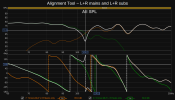
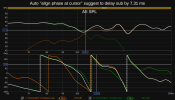
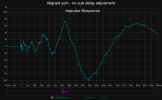
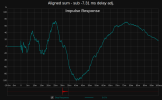
*inverted the IRs
----
Oops... I meant delay mains by 7.31 ms which is really the direct equivalent to -7.31 ms for the subs -- a peculiarity in the alignment tool otherwise the "aligned sum" phase/IR/step outcome will look wrong.
Attachments
-
 bugal1998-7.png53.7 KB · Views: 38
bugal1998-7.png53.7 KB · Views: 38 -
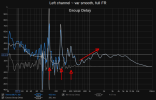 bugal1998-8a.png92.4 KB · Views: 37
bugal1998-8a.png92.4 KB · Views: 37 -
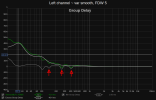 bugal1998-8b.png51.3 KB · Views: 34
bugal1998-8b.png51.3 KB · Views: 34 -
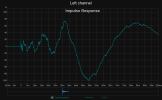 bugal1998-9a.png40 KB · Views: 32
bugal1998-9a.png40 KB · Views: 32 -
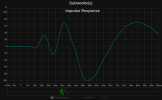 bugal1998-9b.png40.1 KB · Views: 31
bugal1998-9b.png40.1 KB · Views: 31 -
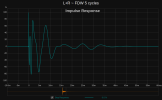 bugal1998-9c.png39.4 KB · Views: 34
bugal1998-9c.png39.4 KB · Views: 34 -
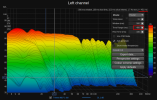 bugal1998-6b.png209.2 KB · Views: 35
bugal1998-6b.png209.2 KB · Views: 35 -
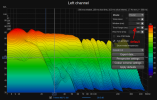 bugal1998-6a.png219.9 KB · Views: 34
bugal1998-6a.png219.9 KB · Views: 34 -
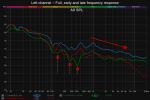 bugal1998-1.png71.7 KB · Views: 35
bugal1998-1.png71.7 KB · Views: 35 -
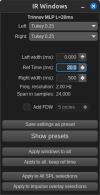 bugal1998-1b.png31 KB · Views: 36
bugal1998-1b.png31 KB · Views: 36 -
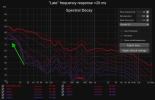 bugal1998-1c.png166.2 KB · Views: 34
bugal1998-1c.png166.2 KB · Views: 34 -
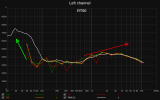 bugal1998-2.png57 KB · Views: 36
bugal1998-2.png57 KB · Views: 36 -
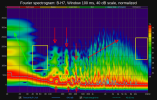 bugal1998-3.png342.6 KB · Views: 32
bugal1998-3.png342.6 KB · Views: 32 -
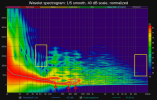 bugal1998-4a.png292.1 KB · Views: 33
bugal1998-4a.png292.1 KB · Views: 33 -
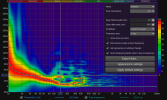 bugal1998-4b.png329.2 KB · Views: 33
bugal1998-4b.png329.2 KB · Views: 33 -
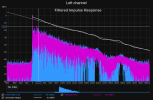 bugal1998-5a.png104.7 KB · Views: 35
bugal1998-5a.png104.7 KB · Views: 35 -
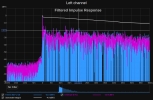 bugal1998-5b.png137.5 KB · Views: 43
bugal1998-5b.png137.5 KB · Views: 43
Last edited:
5-pot-fan
Member
- Joined
- Nov 5, 2021
- Messages
- 67
- Likes
- 55
This looks like a good summary of what I've been looking for over the last 3 weeks! I will run through it in the next couple of days and offer suggestions if I have any.
You mentioned earlier in the thread about REW needing to be able to run a sweep from a hard drive or other source. I am using v5.20.14 beta and have today done something approximating your comment. Played back a previously-recorded sweep file with acoustic ref built in, recorded it and used it the resulting curve to test against an earlier EQ prediction. Sorry if I have misunderstood your comment though. And I don't think it yet does the 2nd point you raised.
You mentioned earlier in the thread about REW needing to be able to run a sweep from a hard drive or other source. I am using v5.20.14 beta and have today done something approximating your comment. Played back a previously-recorded sweep file with acoustic ref built in, recorded it and used it the resulting curve to test against an earlier EQ prediction. Sorry if I have misunderstood your comment though. And I don't think it yet does the 2nd point you raised.
- Thread Starter
- #37
This looks like a good summary of what I've been looking for over the last 3 weeks! I will run through it in the next couple of days and offer suggestions if I have any.
You mentioned earlier in the thread about REW needing to be able to run a sweep from a hard drive or other source. I am using v5.20.14 beta and have today done something approximating your comment. Played back a previously-recorded sweep file with acoustic ref built in, recorded it and used it the resulting curve to test against an earlier EQ prediction. Sorry if I have misunderstood your comment though. And I don't think it yet does the 2nd point you raised.
Thanks, @5-pot-fan. I hope it's helpful... and I welcome any feedback!
BTW, it looks like at least one of the graphs with timing settings in the view limits will need to be updated; I'll have to think about how to clearly articulate how to find the settings.
I need to dig into the RTA function more, but all I've seen thus far in REW documentation was the ability to playback the sweep from some other device, record it, and the import the recording.
I just bought a 35' hdmi cable to use the RTA function in REW.
- Thread Starter
- #38
An overlay of the full frequency response vs windowed "early" FR (e.g. 5 cycles) and "late" FR similar to what the Genelec GRADE report shows...
I attached some more alternate graphical views I personally also would like to study/observe for myself -- others may as well.
Perhaps an "alignment tool" view of the individual mains & subwoofer + their summed response -- note, however, this optimizes at the mic position primarily and may not take into account the far off-axis seating areas alignment.
View attachment 323436 View attachment 323437 View attachment 323438 View attachment 323439
*inverted the IRs
----
Oops... I meant delay mains by 7.31 ms which is really the direct equivalent to -7.31 ms for the subs -- a peculiarity in the alignment tool otherwise the "aligned sum" phase/IR/step outcome will look wrong.
Thanks, @ernestcarl!
1) I'll try the updated subwoofer timing and see what happens.
2) You're taking me into some areas of REW I'm unfamiliar with (excellent!), so I'll have a bit of a learning curve to understand and interpret some of the graphs... And I'll have to figure out how to create them.
- Thread Starter
- #39
I adjusted the subwoofer/mains delay, remeasured, and then the timing tool suggested a different delay. Very confusing. No change in the audible experience that I can key in on.
Also, I've added a rug with padding that brought the elevated decay times down in the elevated ranges, bringing more consistency across the spectrum. Maybe the sound is a little clearer (maybe), but it's clearly much less enveloping. I'm giving my ears time to adjust, before passing judgment, but the upper range for desired non-critical listening decay times in a room my size seems to be around 0.5-0.6 seconds, and my initial reaction is that I prefer the longer end of the the range.
Also, I've added a rug with padding that brought the elevated decay times down in the elevated ranges, bringing more consistency across the spectrum. Maybe the sound is a little clearer (maybe), but it's clearly much less enveloping. I'm giving my ears time to adjust, before passing judgment, but the upper range for desired non-critical listening decay times in a room my size seems to be around 0.5-0.6 seconds, and my initial reaction is that I prefer the longer end of the the range.
REW version 5.30 final release is out as of today:
 www.roomeqwizard.com
www.roomeqwizard.com
REW room acoustics and audio device measurement and analysis software
REW is free software for room acoustic measurement, loudspeaker measurement and audio device measurement and analysis
Similar threads
- Replies
- 45
- Views
- 5K
- Replies
- 23
- Views
- 2K
- Replies
- 16
- Views
- 3K
- Replies
- 4
- Views
- 721
